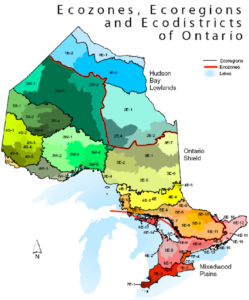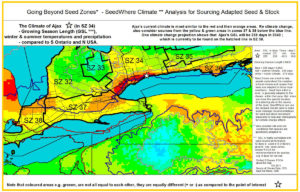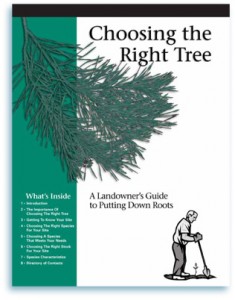Many areas of southern Ontario have lost significant amount of forest cover. While in some areas, forests can naturally regenerate from the edges of existing forests, tree planting programs can help expedite what can be a decades long process. But tree planting is not an easy thing to do well – success requires planning and a lot of hard work over several years – whether it’s 1 tree in a city, or 10,000 in the country.

1. Planning Ahead
To get the seed or seedlings of the right species and seed source for your site, and to get operational help to prepare the site, start planning at least a year ahead of planting time.
Consult resources below.
a. Know Your Site
Is it low and wet, or high and dry? Are the soils deep or shallow; sand, loam or clay? Again consult the resources below to get help with this very important part of planning.
b. Pick Your Species

Over 100 trees and shrubs are native to Ontario, but they are adapted to different site conditions. Silver maple is adapted to moist sites but white oak does better on upland sites. Sugar maple does better in a more shaded environment while red pine requires open conditions. Black walnut requires a richer soil such as a clay loam to grow well; white pine does well on sandy loams.
Choose species that suit your site and then your needs whether that is forest cover, wildlife habitat, wind breaks, timber or other forest products or all of the above. For a list of species native to your area and that are suited to reforestation conditions, click here.
c. Know your local climate—use Eco-districts

Are your summers dry, winters long? Is your climate challenged by high elevation or moderated by a Great Lake? Trees vary in their adaptability to climate conditions.
Ontario’s Eco-districts can help you buy trees that are adapted to your local climate. Always ask the nursery where the seed came from to determine if the seedlings will be adapted to your area. Go to the Ontario Tree Seed Atlas, which contains detailed maps of Ontario’s Eco-districts.
WHY IS THIS IMPORTANT? Learn about Ontario’s Natural Selections
Seed Source
Sometimes the species you want is available but not of your local seed source. The FGCA can help you determine if stock from other areas would be safe to consider. Seedwhere, a GIS tool using the Ontario Climate Model, was developed by the Canadian Forest Service (Sault Ste Marie, 1996) to support decisions on moving plant material across climate gradients. If the grower knows the source of their stock Seedwhere can be used to determine if it similar enough to your planting site or if the risk of maladaptation is too great.
 It helps us make the best use of available supplies of seed and trees. Seedwhere is also helping us factor climate change into planting plans, which is especially important for species we expect to thrive for hundreds of years.
It helps us make the best use of available supplies of seed and trees. Seedwhere is also helping us factor climate change into planting plans, which is especially important for species we expect to thrive for hundreds of years.
d. Find Trees
Once you know the species and seed source you need, can call growers to find out what is available or consider ordering a year of more in advance. This is where planning ahead pays off. Don’t buy trees based on price or availability alone. It is better to delay planting a year than waste your money and time on trees that won’t thrive on your site and in your climate.
If a tree is not genetically adapted to your site conditions, no amount of care will help it grow as vigorously as one from the appropriate source. Remember the most expensive planting is a failed planting.
If you have a choice in trees of suitable species and seed source, stock type is the next consideration. If you don’t have a choice, you will need to adapt your site preparation, planting and tending plans to allow for smaller vs. larger stock, bareroot vs. container or potted stock.
The Society for Ecological Restoration – Ontario Chapter (SERO) publishes the Native Plant Resource Guide Ontario (https://chapter.ser.org/ontario/resources/seropublications/) which lists Suppliers of Native Stock. The listing indicates suppliers who follow SERO’s Native Plant Material Suppliers Guidelines as well as those that are certified by FGCA’s Ontario’s Natural Selections seed source certification program. Go to www.ontariosnaturalselections.org to learn about how we are promoting the use of high quality, source identified stock among those working in the seed and stock sector.
2. Plant and Tend Well
Obtaining trees that are adapted to your site and climate conditions is the first essential step in a successful planting project, in recognition of the genetic principles that are in play. But you need to protect this investment by:
- preparing the site to make planting as easy as possible to do well, and to control competing vegetation
- careful handling and planting of these living, perishable trees. A few minutes of exposed roots or a few hours of overheating will harm or even kill trees
- tending your trees over several years to control competing vegetation, protect from insects, diseases and animal damage (mice, voles, deer, porcupines). Be prepared to monitor and take action.
– and remember, the most expensive planting is a failed planting. No amount of tending will help maladapted trees grow as well as those adapted to your site and local climate.
Resources
Choosing the Right Tree
Describes essential elements of tree planting projects. Download the PDF
Landowner Resources
- Forests Ontario
- Society of Ecological Restoration Ontario’s Native Plant Resource Guide Ontario
- The Ontario Woodlot Association and the Landowner Resource Centre (re extension notes) for advice on planning and conducting a planting project.
